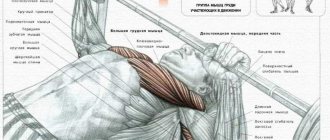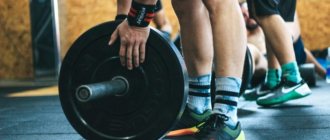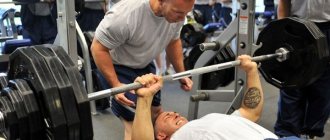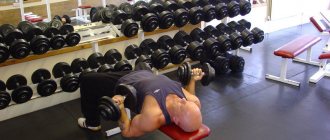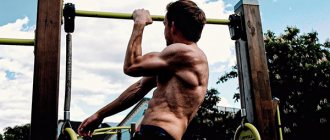Home » Training Center » Training Programs » How to Increase Bench Press - Strength Training Program
How to increase the bench press is probably the most pressing question among the male half of iron sports fans, and it’s true, because most often they are looking for a way not to increase the weight in the deadlift or squat, few people are intrigued by the working weight in the biceps curl, everyone is interested and impressed by the result in the bench press.
Since the bench press is rightfully considered a popular exercise, practice has already proven that by performing only one exercise, the bench press, you can decently develop your upper body without resorting to auxiliary exercises.
If the bench press is such a popular exercise, why can’t most trainees improve their results in it by training year after year with the same working weight and are at a loss as to how to increase the bench press?
The thing is that the bench press is a basic multi-joint exercise, which uses almost all the muscles of the upper body and even the legs. At the same time, many people training in the gym and beyond perform, in addition to the bench press, a number of other exercises for the upper body, and as a rule, all these exercises, including the bench press, are performed with maximum load and intensity. Due to this, the body simply does not have time to recover and the result in the bench press does not increase.
If you want a big bench press, remove unnecessary exercises!
Therefore, if you want to increase your bench press, then the main goal should be to increase the result in the bench press, and all other exercises should be performed as auxiliary exercises.
How to implement this is very simple, if at this stage of training you are pursuing the goal of increasing the result in this exercise, then you should focus specifically on the bench press, in which case a special strength training program should be used.
The goal is the bench press, we think about the bench press.
By performing the bench press fanatically three times a week and without any consistency in loads and intensity, it is almost impossible to achieve an increase in results. In this case, we do not take into account the very initial stage of training with iron, when the body adapts and grows from any load, but consider the option when you have at least six months, or better yet, a year of training and have achieved certain results in the bench press.
Bench press training[edit | edit code]
Yuzhakov Anton All about the bench press
Yuzhakov Anton Close grip bench press
Yuzhakov Anton How to warm up for bench press
Bench press
The program for increasing bench press results is suitable for athletes of intermediate level and above. Author:
Svyatomir
Notes[edit | edit code]
- This program is designed to train the “top” and improve results in the bench press, since it was compiled for a forum member who does not set himself the goal of progressing in squats and deadlifts. It is very close to the Louis Simmons training and was compiled by me for the successful use of “naturals”.
- If you already bench press 120-130 kg, you can start.
- The duration of the program is 18-20 weeks (or more, depending on progress) with 2 workouts per week.
- At this stage there are no board presses and statics (there will be statics if the requirements specified in “workout 2” are met). They may be needed in the future.
- Since you are not going to train the bottom, and this is highly desirable, include very light squats as a warm-up at the beginning of Workout 1, and perform deadlifts every 2 weeks, as indicated in Workout 2. If you don’t want to pay attention to the “bottom” at all, there’s no need, but then replace the deadlift with shrugs with a standing barbell in the 50%*8, 75%*6 + 2*6-8 mode.
- After this program you will need to squat with a barbell in any case because... The lifting press technique requires strong hips. Caviar - as needed.
- Hyperextensions are performed once a week to prevent compression of the spine in the “bridge” during heavy bench presses (“workout 1”).
- The workouts will be long, up to an hour and a half - there’s no rush. Perhaps you have not trained like this before and at first it may seem very voluminous. I painted the volume according to “natural” realities; It won’t be easy, but in 3-4 weeks you’ll get the hang of it.
- Every 4 weeks you should add 3-4 days of rest i.e. “shift” the training by one workout or give a full week of rest every 5-6 weeks.
- A strong grip is important; if it is not strong enough, hang from the horizontal bar at every workout, and not just at the end of “workout 2.”
- If necessary, adjust your bench press technique using information on PL websites and training from more experienced lifters. Don't try this singles program without perfecting your technique.
- Warm-up percentages are indicated for calculation at the beginning of the program. Do not change the warm-up weights until the end of the program, or decide for yourself when to increase them slightly. The main thing is to warm up and not get tired before working approaches.
- The “back room” varies periodically, which makes it possible to progress for a long time and without “stagnation”. In the “auxiliary” exercises you will need to work as hard as possible.
- By following the program exactly and taking into account all the recommendations outlined, you can count on a minimum increase in bench press of 7.5 kg within the specified period (i.e. in 5-6 months, including additional days of rest). In the case of a successful “pressing” structure of the shoulder girdle and a favorable situation (nutrition, rest, minimal extra-training stress, etc.), the increase can reach 10-12.5 kg (especially if you have not trained like this yet and are currently only benching 120 kg). I created a similar program for one of my friends, who increased his 1RM in the bench press by 10.5 kg in 5 months (from 122.5 kg to 133 kg).
Program[edit | edit code]
Workout 1
1.
Bench press (speed, weight 60% of 1RM) - very light warm-up * 8, 5 * 3 (60% of 1RM) + 1 * 3 with a weight of 10-12.5 kg more than 60% (monitor if the speed does not drop bench press).
- This 60% is constantly recalculated depending on the record bench press in the 2nd workout. Be sure to use small pancakes or homemade “makeweights”.
2a.
Bench press with a narrow grip (40cm between the palms) - 60% * 5, 2 * 4-6.
2b.
Shoulder press from the chest (standing or sitting) 50-55%*5, 2*4-6.
Alternate options 2a and 2b every workout. If you have very strong triceps, but do weak chest presses while standing/sitting (for example, 70-75kg*5 from the chest with a bench press of 125-130kg*5) - perform each such workout only option 2b (preferably standing, pushing as necessary) . In this case, every 4th workout, replace the front chest press with a seated dumbbell press or barbell raises from the floor - 40% * 6, 70% * 6 + 2 * 5-6.
2a(+)
.
Sitting dumbbell flyes with a slight tilt of the body forward - 2 * 6 (in the 2nd approach, do partial repetitions until you can lift only 1/3 of the amplitude). 2b(+)
. Extensions on the upper block while standing (preferably with a rope, not an adapter) - 2 * 6-8.
Alternate options 2a(+) and 2b(+) during each workout. These are optional exercises, but they are desirable for variety.
If you don’t want to, don’t do it, but then add 1 approach to option 2a (you’ll get 3*3-5, not 2*4-6), and after option 2b do a vertical front row (standing, with a medium grip; pull the bar to the bottom chest) - 1*8-10.
3.
Pull-ups to the chest with a grip slightly wider than shoulder width - 1*6 without load, 1*6-8 with load, 1*max without load.
If your own weight is high and you can’t do a full pull-up, do the same on the upper block with 2 warm-ups + 2*6-8. IMHO, pull-ups are a priority.
4.
Bent-over barbell rows - 40%*6, 60%*6, 2*5-6 + partial repetitions in the 2nd approach. Watch your technology!
Do this exercise for 2 weeks after pull-ups, and another 2 weeks before them, etc. When pull-ups follow the rows to the belt, do 2*max pull-ups without a load on the belt and that’s it.
5.
Hyperextensions - 1 * 8-10 without a load + 2-3 * 8 with a load behind the head or in lowered hands (you can take a small barbell).
6.
Full-amplitude “twisting” while lying down with legs secured and a load behind the head - 1*8 without load, 1*6 (5-10kg) + 2*6-10.
Workout 2
1.
Bench press (power, singles) - 40%*8, 55%*5, 70%*1, 80%*1, 90%*1, 100%*1, record*1.
- Small gains of 1-0.5 kg (from workout to workout) rule here, so get the appropriate pancakes or small homemade “makeweights”. Don’t even try to try to gain 2.5 kg at once! When going for a record, you need to know that you will probably press the weight. Failed attempts to squeeze more will lead to a “rollback” of the scales. If you are very tired that day or simply don’t feel “raring to go”, postpone the workout or consolidate the result of the previous record.
Rest between work sets for 4-5 minutes or more.
- A high-quality general warm-up with light stretching of the pectoral muscles and general warm-up is a must. The insurance of a knowledgeable partner goes without saying. Working in singles is dangerous for ligaments and joints, so if you experience any discomfort, stop training immediately! You probably don't need a shoulder injury, a torn anterior deltoid, or a torn pectoral muscle. In general, do not start this program if you do not have experience in singles!
2.
French bench press - 40% * 8, 70% * 5, 2 * 8 (the one for whom the program was written will prescribe the approaches/repetitions if he wants differently).
- IMHO, sooner or later, a regular French press will hurt your elbows. In this case, it is better to do it while lying on the floor, powerfully tearing the barbell standing behind you up and quickly lowering it, dropping it to the floor behind your head. In this case, do 3*5, which will give functional strength to the triceps in the bench press. The result is an incomplete amplitude because the bar is 22.5cm from the floor due to the large plates, but that’s how it should be.)
3a.
Press from the plinths (lifting the barbell from the plinths from a position just above the “dead center”) - 1*1.
The weight will be much less than in the 1RM (figure it out for yourself; try it in the 1st lesson and in no case overexert yourself by choosing an adequate weight). 3b.
Dumbbell bench press at an angle of 30″ - 1*15-20 to failure or regular push-ups from the floor - 1*max. Press dumbbells or do push-ups at a moderate-fast pace.
- Alternate options 3a and 3b every workout.
- You can not do exercises 2 and 3 at all, replacing them with static holds of the barbell while lying down (at each such workout) - 3 * 12-15 seconds. This will allow you to thoroughly strengthen the ligaments and confidently progress in the bench press. If you have not previously practiced statics, start with a weight that is 10 kg less than 1RM (in the bench press) for the 1st approach and add 5-7.5 kg in each of the next two approaches. Each workout, increase the weight in all approaches by 2.5-5 kg depending on your strength. Limiters (power frame, etc.) must be installed 5 cm below the bar. If there is no load frame, racks with limiters or plinths, don’t even try to use statics! Working weights will soon become much higher than 1RM, and a barbell crushing you is a guarantee of injury (at best).
4a.
Parallel grip row on the upper block or overhead row (choose one option that is convenient for you) - 40% * 6, 70% * 6, 2 * 6-8
4b.
Deadlift (for general development) - 40%*8, 60%*5, 80%*3, 2*5-6 (don’t force it, but watch your technique; try to pull with your legs).
- Alternate between options 4a and 4b each workout, or do shrugs instead of deadlifts as indicated in the notes.
5a.
Standing straight bar curls - 40%*6, 70%*6, 2*5-6 + “hammer” 1*5-6
5b.
“Hammer” - 40%*6, 70%*6, 2*5-6 (if on this day you decide to perform shrugs rather than deadlifts, do “hammer” curls not 2*5-6, but 3* 5-6.
- Alternate options 5a and 5b every workout.
6.
Full-amplitude straight leg raises while hanging on the bar - 1*max + 2 sets of hanging until “you fall” to strengthen your grip (if it’s easy, wrap a towel around the bar).
Below are the most popular and working bench press programs
You can find a large number of bench press programs in books here.
- Butenko
- Verkhoshansky
- Muravyov
- Surovetsky
- Sheiko
- Soloviev
- Chernyshev
- Ed Cohen
- Ted Arcidi
- Bench Press Bridge Training
- Six Week Program to Increase Bench Press
- How to increase your bench press
- Program for a pure bencher
- Big press
- Overcoming sticking point in the bench press
- Weak pressure
- Weak drop from the chest
- Using circuits
- 6 Weaknesses in the Bench Press
- 7 mistakes when bench pressing
- Board press
Alternative workout for the bench press[edit | edit code]
Workout 1
- Press (according to the diagram)
- Horizontal block pull (rowing) - 3x8-10
- Press up from racks 85-90% x 2-4 times in different workouts.
- Lying dumbbell fly - 3x8-10
Workout 2
- Press - (pyramid - only in the preparatory cycle - according to the scheme)
- Standing press - 5x3
Workout 3
- Press (according to the diagram)
- Traction on the block horizontally - 3x8-10
- Dips - 5x4-6
- Lying dumbbell fly - 3x8-10
Workout 4
- Press (different in different weeks, but light - 65% - 4x6, or 70% - 5x5, or 75% - 5x3.
- Biceps curl 3x6-8
- Standing press 5x4-5
About the bench press
The bench press is the most popular exercise, not because it is competitive, but because it is the main movement for pumping up and growing the chest muscles, which perfectly shapes the chest; when performing this exercise, several muscle groups are trained at once, so the bench press lying down barbells are a basic exercise that must be included in your training program every session, when performed, the main muscle group on which the load is created, and the emphasis is on the chest, middle, lower, upper, part, many people think that only the middle part works part, but this is not the case, the entire chest is trained.
Static exercises
It will be useful to work with static loads a couple of times a month. They can be performed on the same bench, only the bar needs to be firmly fixed to the racks.
Their benefit is to improve the functioning of joints and nerves.
The brain sends a signal to the muscles to lift the load, since it is fixed and does not move, the efforts will be applied more and more, reaching the maximum.
This is a great way to increase your strength. Static exercises can also be performed at home.
To do this, it is enough to try to push a wall, only a strong one, or push apart a door frame. But first you need to warm up your joints properly to avoid injury.
The program that allowed the champion to lift more than 300 kg
First day:
- Barbell press 5X12.
- Squat 5X5.
- Dumbbell flyes 15X4.
- Pull-ups 50 times.
Second day:
- Deadlift 5X5.
- Pull-ups with weight 15X4.
- Push-ups 100 times.
- Bars 50 times.
The third day:
- Heavy bench press 5X5.
- Dumbbell press 5X5.
- Stretching.
Please note that on the first day Kirill performs the exercise with an average weight, allowing him to do up to 12 repetitions.
This prepares the muscles for the fact that in the third workout it will mercilessly destroy this muscle group.
In addition, he remembers to do the rest of the basic sets, which makes his body evenly developed.
Methods for hypertrophy
mTOR activation
Every repetition counts here. Emphasizing the eccentric (negative) phase of the movement and stretching the muscles under load maximizes mTor activation. The mTor activation method is as follows:
- Lower the bar for 5 seconds, tensing the target muscles as hard as possible.
- At the point of maximum muscle stretch, pause for 2 seconds.
- Repeat 6-8 times, on the last repetition hold the position at the point of maximum muscle stretch for as long as possible. This method provides only one approach.
In action it looks like this:
“Heavy” myo-repetitions
To maximally fatigue muscle fibers, use myo-repetitions, “invented” by Borg Fägerli. They are similar to the rest/pause method. Go to failure (or close to it) and then do (with 20-second rest breaks) as many microsets of 3 reps as you can.
When you start getting only 2 reps in micro sets, it’s time to stop. The very first set can be any number of repetitions (6-20), but for this program it is better to take a weight with which you can do 6-8.
Do as many reps as you can with that weight, rest for 20 seconds, and do 3 more reps. Rest 20 seconds and do 3 more reps. Stop when you can only do 2 reps. If you succeeded in more than 5 microsets, most likely you deceived yourself - you did not reach failure in the very first approach.
Example:
Voltage level
The best program done with 80% effort will not give you the same results as the easiest program done with 100% effort. This is the most important thing you need to remember. In other words, intense training is required for impressive results.
With the exception of the strength-skill method, the load volume is low: you only need to perform one working set of each exercise. Therefore, you need to extract as much benefit from each approach as possible. If you finish them too early, the growth in muscle mass and strength abilities will not be as fast as it could be.
Training should be short but very hard. If they turn out to be short and not heavy, you shouldn’t expect rapid progress!
Triceps workout
Exercise 5: Lying Triceps Extension
- You will need:
a weight bench, a straight barbell, or a barbell with a curved W bar. - What muscles are worked:
triceps. - Performing the exercise:
lie on a bench with your feet on the floor. Hold the barbell with a reverse grip (palms facing your face) or straight grip (easier for beginners), with your hands shoulder-width apart. Without bending your elbows, bend your forearm to lift the bar above your forehead. From this position, extend your forearms to lift the barbell overhead. - Breathing:
inhale in a low position, exhale while lifting the bar. - Safety precautions:
Gently lower the barbell by flexing your forearms. Be careful not to flare your elbows out to the sides as you lower the barbell to your forehead.
Strengthening your back
Exercise 4: Dumbbell Raise
- You will need:
weight bench, 1 dumbbell. - What muscles are worked:
latissimus dorsi, teres major, posterior deltoid (back of the shoulder), radialis brachii. - To do the exercise:
stand next to a bench. Place one knee on the bench. Hold a dumbbell in one hand and rest your other hand on the bench. Tighten your back, then move your elbow back as high as possible and lift the dumbbell. - Breathing:
Inhale while the dumbbell is in the lower position, holding your breath throughout the movement. Exhale as you lower the dumbbell. - Safety precautions:
To protect your lower back, keep your back straight during the exercise. With each repetition, lift the dumbbell without any sudden movements.
What All Straight Men Should Know
As a natural, you may have already tried many advanced programs and found them not very effective. This could happen for several reasons:
1. The main enemy of a straight person is too high a level of cortisol.
This is especially true if it is constantly elevated. Cortisol can significantly limit muscle growth: first, by increasing protein/muscle catabolism and decreasing protein synthesis, and second, by increasing myostatin production.
2. The volume of training load has the most significant effect on cortisol levels.
The main function of cortisol during physical activity is to mobilize stored energy. The more energy you expend during training, the more cortisol is produced. Therefore, the higher the load volume, the more cortisol. What conclusions can be drawn? Natural athletes cannot perform the same amount of work as athletes taking steroids and still expect optimal muscle growth.
3. Naturals cannot artificially increase the rate of protein synthesis.
They do not use anabolic drugs, therefore, the rate of protein synthesis depends almost entirely on training (and nutrition). Under normal conditions, the rate of protein synthesis in the trained muscle remains elevated for 24 hours after exercise. Then it decreases to normal levels.
For naturals who train a muscle only once a week, the growth of muscle mass will be quite slow - the rate of protein synthesis increases too rarely. Natural men will gain muscle growth faster if they train a muscle twice a week, and even faster if they can do it three times a week.
4. Training volume and frequency are inversely proportional.
The more often you train, the lower the volume of the load should be if you expect to increase muscle mass or strength.
The fundamental principles for naturals are:
- Train muscle groups more often—ideally 3 times a week—to increase your protein synthesis rate more often.
- Limit the amount of load - otherwise frequent training will become impossible.
- Since the number of working approaches will be small, give your best in each of them.
- Use different methods to stimulate muscle growth.
With all that said, let's move on to the program itself.
